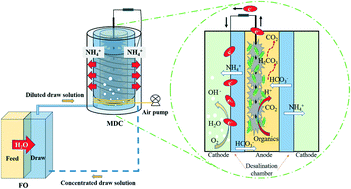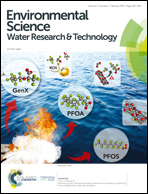Ammonia removal and recovery from diluted forward osmosis draw solution by using a tubular microbial desalination cell
Abstract
Energy-efficient regeneration of draw solution for forward osmosis (FO) is critically important to FO development and applications. In this study, microbial desalination cells (MDCs), an emerging technology for simultaneous desalination and wastewater treatment, were employed to remove and recover ammonia nitrogen from mimicked FO draw solution. This tubular MDC could remove 72.1 ± 5.5% of the ammonium nitrogen from the desalination chamber, of which 68.6 ± 4.6% was recovered in the catholyte. The effects of external resistance, initial salt concentration and anolyte buffer on MDC performance were also studied. It was found that a low external resistance of 10 Ω was essential for maximizing the electricity generation and thus nitrogen removal. Compared to the high initial salt concentration, the lower concentration of 0.25 M was beneficial for enhancing the desalination efficiency to approximately 84% and a nitrogen recovery efficiency to 78%. Moreover, the MDC could maintain comparable performance regardless of the use of phosphate-based buffer and the migrated HCO3− ions might introduce additional buffer capacity into the anode. The results of this study are expected to encourage further investigation to optimize nutrient removal and recovery in MDCs and assist with FO implementation.



 Please wait while we load your content...
Please wait while we load your content...